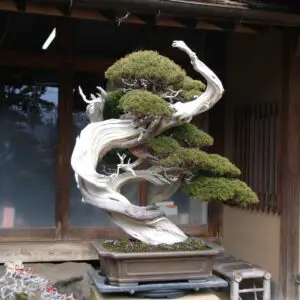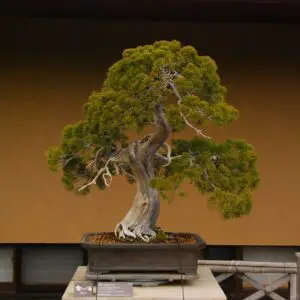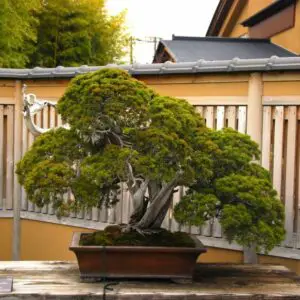For optimal growth, place juniper bonsai outdoors where they can receive 6+ hours of full sun and enough airflow. Juniper bonsai are naturally outdoor plants and they require special care and equipment to thrive if they are brought indoors.
Juniper bonsai: sunlight requirements
Sunlight requirements: in general

One of the key elements of bonsai cultivation is proper placement as the right location can mean the difference between a healthy, thriving bonsai and one that struggles to survive. Juniper bonsai are hardy trees that can survive in a variety of conditions, but they still have specific needs when it comes to sunlight.
Juniper bonsai need full sun, though partial shade is acceptable.
In their natural habitat, juniper trees grow in a wide range of lighting conditions, from full sun to partial shade but not in full shade. So, when grown as bonsai, junipers require bright, direct light for at least 6 hours a day to stay healthy and develop properly.
They can tolerate some shade, but if they don’t get enough sunlight, they may develop weak, spindly growth, and their foliage may turn yellow or drop off.
Sunlight requirements: by species
There are many species of junipers and the amount of sunlight they require can vary depending on their specific needs and growing conditions. Here are some examples of different juniper species and their sunlight requirements.
Juniperus chinensis var. sargentii (Shimpaku juniper)
Shimpaku juniper prefers full sun and can tolerate some shade, but it will not grow well in deep shade.
Juniperus communis (common juniper)
Common juniper prefers full sun to partial shade.
Juniperus horizontalis (creeping juniper)
Creeping juniper prefers full sun but can also tolerate some shade.
Juniperus scopulorum (Rocky Mountain juniper)
Rocky Mountain juniper prefers full sun to partial shade and can tolerate some shade, but it will not grow well in deep shade.
Indoor vs. outdoor: where to place juniper bonsai?

Juniper bonsai style (coiled trunk)
Which is better, indoor or outdoor?
While juniper bonsai can be grown indoors, it is much easier to maintain their health and longevity when you place them outdoors. This is because juniper bonsai are outdoor plants by nature and they will not thrive indoors without special care and equipment. Junipers prefer full sun and require good airflow, which can best be provided outdoors.
Where to place juniper bonsai outdoors
If you are planning to place your juniper bonsai in your garden, here are some things to consider when finding the right spot.
Sunlight
Most juniper bonsai require full sun to thrive. Make sure the spot you choose receives at least 6+ hours of direct sunlight per day. Walls, houses, or other trees in your garden can make deep shade depending on hours in a day or season.
Space
Your juniper bonsai will need enough space to grow and develop its foliage. Placing juniper bonsai trees closer together in a tight place is not a good idea. Make sure the spot you choose provides ample space for your bonsai to grow.
Is a balcony/terrace good for juniper bonsai?
If you have a balcony or terrace, they can make great locations for your juniper bonsai as they often provide ample sunlight and fresh air. However, there are 2 things to consider before placing your bonsai on a balcony or terrace.
Temperature
Balconies and terraces can be very hot, particularly when they are exposed to direct sunlight. The floor can be heated pretty intensely even in winter and this extreme heat is harmful to your bonsai trees.
If this is the case, place your trees on a shelf, preferably in wood or other materials which do not absorb heat or cold, and move your bonsai indoors when necessary.
Wind
Balconies and terraces can be quite windy when you live higher up, which can be damaging to your juniper bonsai. Strong winds can cause the foliage to dry out or break off. To protect your bonsai, consider placing it in a sheltered area or using a windbreak such as a screen.
Can a juniper bonsai survive indoors?

Juniper style (informal upright)
Juniper bonsai can be grown indoors, but they require the right amount of light, temperature, humidity, and airflow to thrive.
One of the biggest challenges of growing juniper bonsai indoors is providing them with enough light as they need bright, direct sunlight for at least 6 hours a day.
The following table shows the intensity of light in mid-day in different conditions. Note that these numbers are generalized and they may vary depending on where you live and which season you are in.
Light intensity (mid-day)
| Place | Light intensity (lux) |
| Outside (sunny day) | 100,000 – 120,000 |
| Outside (under shade on a sunny day) | 5,000 – 15,000 |
| Outside (cloudy/rainy day) | 1,000 – 5,000 |
| South-facing window∗ | max 10,000 |
| Workstation at office | 500 |
| Dining area | 150 – 200 |
∗ Nothing between bonsai and the sun but normal clear glass on a sunny day.
Let’s say about 1/3 of the year you get sunny days for your juniper bonsai. On those days, they get about 100,000 – 120,000 lux of sunlight when they are placed outside vs. the maximum 10,000 lux of sunlight at the south-facing window, which is 1/10 the light intensity.
If you place your juniper bonsai in the dining area, the light intensity is too low for it to survive at all. This means that placing them at a south-facing window is absolutely necessary and the only option for growing juniper bonsai indoors.
To be clear, it is not somewhere around the south-facing window but AT the south-facing window without anything in between your juniper bonsai and the normal clear glass (without UV cut or any other effects).
FYI, eastern and western windows receive about 60% of the intensity of southern exposures, while northern windows only receive 20% of the intensity, which is too low for juniper bonsai.
Also, you need to supplement light with artificial grow lights to ensure they are getting enough of it.
How to grow juniper bonsai indoors

Juniper style (informal upright)
Light
If you are considering growing a juniper bonsai indoors, the first thing you have to consider is the light, specifically the following.
- Intensity of light
- Duration of light
- Quality of light
- Distance from light
- Light cycles.
Intensity of light
The strength of light that a juniper bonsai tree gets is affected by how far away the light source is. If the light source is far away, the light is weaker. The strength of light affects many important things in plants, like how they make their energy through photosynthesis, how long their stems grow, and how their leaves look.
When growing juniper bonsai indoors, things like curtains or screens on windows, and the shade from other things like trees or buildings can all change the strength of light that your bonsai tree gets.
Make sure there is nothing in between the window and your tree for it to grow and stay healthy.
Duration of light
Juniper bonsai requires a certain number of hours of light each day to grow and thrive. Generally, they need at least 8 to 12 hours of light per day, of which 6+ hours of direct sunlight.
Quality of light
The quality of light can also impact the growth of juniper bonsai. Natural sunlight contains a full spectrum of light, including blue and red wavelengths. Both blue and red lights are important for plant growth but more so for blue ones because it stimulates the production of chlorophyll (green on leaves).
Cool-white fluorescent lights have mostly blue light and are good for growing foliage plants like juniper.
Incandescent lights, on the other hand, mostly have red and some infrared light, but very little blue light. Fluorescent lights have different colors of light depending on the kind of phosphorus used.
When using artificial grow lights, it is important to select ones that emit blue to a full spectrum of light to ensure the health and growth of your juniper bonsai.
Distance from light
When using artificial light, the distance between the light source and the juniper bonsai can also impact its growth. If the light source is too close, it can cause heat stress or burn the foliage. If it is too far away, the tree may not receive enough light.
It is important to position the light source at the right distance and angle to provide adequate light without causing damage.
Light cycles
Most plants require a certain amount of darkness each day to complete their growth cycle. Though it may not kill your tree, it is better to provide your juniper bonsai with a consistent light cycle, ideally with 8 to 12 hours of light followed by 12 to 16 hours of darkness each day.
Temperature
It is important to give your juniper bonsai some degree of temperature changes during the day and night as lower nighttime temperatures help it recover from moisture loss during the daytime. Cool nighttime temperatures are actually more desirable for their growth than high temperatures.
Keeping a constant temperature is comfortable for humans but not for your bonsai tree. A good rule of thumb is to keep nighttime temperatures 10 to 15 degrees F lower than daytime temperatures.
Humidity
Another thing to consider is raising the humidity around the juniper bonsai.
Water is constantly evaporated during the daytime through the leaves in a process called transpiration, which keeps trees from overheating. So, they need much higher humidity than the dry, heated environment of most homes.
To address this, you can mist the foliage of your juniper bonsai regularly or use a humidifier to increase humidity levels around them.
Airflow
The last thing to consider is to constantly give your juniper bonsai fresh air.
Plants require carbon dioxide from the air for photosynthesis. Without proper air circulation, carbon dioxide can be quickly depleted by photosynthesis, leading to reduced or unhealthy growth. They also need oxygen for root respiration.
You can open the window regularly or use a fan to create gentle airflow for your trees.
How long can a juniper bonsai live indoors?

Juniper style (Mutiple trunks)
Juniper bonsai can live indoors for many years if they are given the proper care. Without any special treatment, however, they may only survive for a couple of weeks. After that, the foliage gradually starts to turn yellow and the trees may eventually weaken and die.
Indoor environments can be very challenging for juniper bonsai because they typically have lower light levels, drier air, and more stable temperatures than outdoor environments. These conditions can make it difficult for juniper bonsai to grow and thrive if they are not given the proper care.



